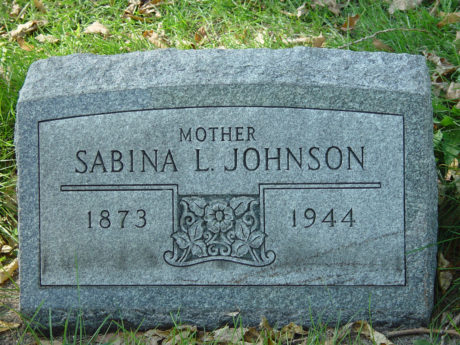There’s Always More to the Story: A Mother Waits and Watches
By SUE HUNTER WEIR
At first glance, Sabina “Louise” Johnson’s looked like an ordinary, uneventful life. But there was much more to her story than that.
Sabina “Louise” Nordstrom was born in Orebro, Sweden on March 14, 1873. Her family sailed on the U.S. Celtic from Liverpool in 1879. On June 20th, they arrived in New York. Louise was six years old. Three of her siblings (Hulda, aged 9, Mathilda, aged 8, and Carl, aged 1) were also on board.


Her family first settled in North Dakota, where her sister Ellen was born on March 8, 1885. At some point Sabina moved to Minneapolis, where she married John G. Johnson on November 4, 1896.
They had four children: Arthur, born 1897; Myrtle, born 1898; John “Clifford” Johnson, born 1899. Myrtle died on October 7, 1902, from appendicitis; she was four. Two weeks after Myrtle died, Louise gave birth to a son, Charles Stanley.
Sometime between 1900 and 1910, when the federal censuses were taken, John Johnson disappeared. Louise described herself as a widow in the 1910 census, and, although there were many men named John Johnson who died in Hennepin County during that decade, none of them appear to have been him. In subsequent city directories, she is listed only as Mrs. Louise Johnson without the customary mention that she was the widow of John.
She worked as a seamstress to provide for her sons and to guarantee that they got an education. During World War I, the company that she worked for sewed uniforms for soldiers and sailors.
That work was not her only contribution to the war effort. On December 9, 1917, the Minneapolis Morning Tribune reported that John “Clifford” Johnson, Louise’s middle son, was one of 44 men saved when the U.S.S. Jacob Jones was torpedoed by a German U-boat about 100 miles off the coast of Land’s End, England. The warship was the largest vessel of her class and the first American ship sunk by a U-boat. From the time that it was hit by torpedoes, it took only seven minutes to sink.
Two days after the story reported that 17-year-old Clifford was among the survivors, a second story appeared. According to that story, his mother had been notified that her son was “among the missing, if not among the dead.” And ten days after the first story, a third ran that said that Louise had been informed “that her son was among the missing and that no hope could be held out that he had been saved.” But she still held out hope that the first report was the right one, although there were signs that her hope was wavering. She said: “Somehow, I am content to know that he is dead. During the week after the ship went down, I didn’t act like a real American mother should.” Although she didn’t describe how she thought that she should have behaved, American mothers were being reminded by the papers, and no doubt many other sources, that they should consider it an honor to sacrifice their sons for a good cause. She continued: “…as the hours go by, I am getting to think more and more of what a real honor it is to be the mother of one of the first who could go down fighting…” Another of her comments show how deep anti-German sentiment was at the time: “…rather than think he was a captive of Germans I would feel happy that my prayers were answered to know he had been taken by the more merciful sea.”
In the meantime, she watched and waited. As it turned out, the first report was correct. Clifford spent several hours floating on a life raft in frigid water before he and a handful of other men were rescued by British merchant sailors. Two days later, he was transferred onto a different ship at which point the Navy lost track of him. He was eventually located, and in February 1918, Louise and Clifford were reunited when he came home on furlough.
Louise continued working as a seamstress until a year or two before she died. She died from lymphoma in Norwegian Deaconess Hospital on March 25, 1944. She was 71 years and 11 days old. She was buried next to her daughter Myrtle. Ellen Nordstrom, Louise’s younger sister, died on August 6, 1962, and was buried near Louise and Myrtle. Ellen was 77 years old and had lived with Louise from 1904 until Louise died in 1944.
Sue Hunter Weir is chair of Friends of the Cemetery, an organization dedicated to preserving and maintaining Minneapolis Pioneers and Soldiers Cemetery. She has lived in Phillips for almost 50 years and loves living in such a historic community.









